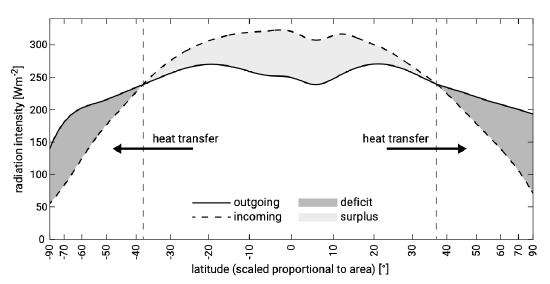4.2.1: Solar radiation and temperature distribution
- Page ID
- 16310
\( \newcommand{\vecs}[1]{\overset { \scriptstyle \rightharpoonup} {\mathbf{#1}} } \)
\( \newcommand{\vecd}[1]{\overset{-\!-\!\rightharpoonup}{\vphantom{a}\smash {#1}}} \)
\( \newcommand{\id}{\mathrm{id}}\) \( \newcommand{\Span}{\mathrm{span}}\)
( \newcommand{\kernel}{\mathrm{null}\,}\) \( \newcommand{\range}{\mathrm{range}\,}\)
\( \newcommand{\RealPart}{\mathrm{Re}}\) \( \newcommand{\ImaginaryPart}{\mathrm{Im}}\)
\( \newcommand{\Argument}{\mathrm{Arg}}\) \( \newcommand{\norm}[1]{\| #1 \|}\)
\( \newcommand{\inner}[2]{\langle #1, #2 \rangle}\)
\( \newcommand{\Span}{\mathrm{span}}\)
\( \newcommand{\id}{\mathrm{id}}\)
\( \newcommand{\Span}{\mathrm{span}}\)
\( \newcommand{\kernel}{\mathrm{null}\,}\)
\( \newcommand{\range}{\mathrm{range}\,}\)
\( \newcommand{\RealPart}{\mathrm{Re}}\)
\( \newcommand{\ImaginaryPart}{\mathrm{Im}}\)
\( \newcommand{\Argument}{\mathrm{Arg}}\)
\( \newcommand{\norm}[1]{\| #1 \|}\)
\( \newcommand{\inner}[2]{\langle #1, #2 \rangle}\)
\( \newcommand{\Span}{\mathrm{span}}\) \( \newcommand{\AA}{\unicode[.8,0]{x212B}}\)
\( \newcommand{\vectorA}[1]{\vec{#1}} % arrow\)
\( \newcommand{\vectorAt}[1]{\vec{\text{#1}}} % arrow\)
\( \newcommand{\vectorB}[1]{\overset { \scriptstyle \rightharpoonup} {\mathbf{#1}} } \)
\( \newcommand{\vectorC}[1]{\textbf{#1}} \)
\( \newcommand{\vectorD}[1]{\overrightarrow{#1}} \)
\( \newcommand{\vectorDt}[1]{\overrightarrow{\text{#1}}} \)
\( \newcommand{\vectE}[1]{\overset{-\!-\!\rightharpoonup}{\vphantom{a}\smash{\mathbf {#1}}}} \)
\( \newcommand{\vecs}[1]{\overset { \scriptstyle \rightharpoonup} {\mathbf{#1}} } \)
\( \newcommand{\vecd}[1]{\overset{-\!-\!\rightharpoonup}{\vphantom{a}\smash {#1}}} \)
\(\newcommand{\avec}{\mathbf a}\) \(\newcommand{\bvec}{\mathbf b}\) \(\newcommand{\cvec}{\mathbf c}\) \(\newcommand{\dvec}{\mathbf d}\) \(\newcommand{\dtil}{\widetilde{\mathbf d}}\) \(\newcommand{\evec}{\mathbf e}\) \(\newcommand{\fvec}{\mathbf f}\) \(\newcommand{\nvec}{\mathbf n}\) \(\newcommand{\pvec}{\mathbf p}\) \(\newcommand{\qvec}{\mathbf q}\) \(\newcommand{\svec}{\mathbf s}\) \(\newcommand{\tvec}{\mathbf t}\) \(\newcommand{\uvec}{\mathbf u}\) \(\newcommand{\vvec}{\mathbf v}\) \(\newcommand{\wvec}{\mathbf w}\) \(\newcommand{\xvec}{\mathbf x}\) \(\newcommand{\yvec}{\mathbf y}\) \(\newcommand{\zvec}{\mathbf z}\) \(\newcommand{\rvec}{\mathbf r}\) \(\newcommand{\mvec}{\mathbf m}\) \(\newcommand{\zerovec}{\mathbf 0}\) \(\newcommand{\onevec}{\mathbf 1}\) \(\newcommand{\real}{\mathbb R}\) \(\newcommand{\twovec}[2]{\left[\begin{array}{r}#1 \\ #2 \end{array}\right]}\) \(\newcommand{\ctwovec}[2]{\left[\begin{array}{c}#1 \\ #2 \end{array}\right]}\) \(\newcommand{\threevec}[3]{\left[\begin{array}{r}#1 \\ #2 \\ #3 \end{array}\right]}\) \(\newcommand{\cthreevec}[3]{\left[\begin{array}{c}#1 \\ #2 \\ #3 \end{array}\right]}\) \(\newcommand{\fourvec}[4]{\left[\begin{array}{r}#1 \\ #2 \\ #3 \\ #4 \end{array}\right]}\) \(\newcommand{\cfourvec}[4]{\left[\begin{array}{c}#1 \\ #2 \\ #3 \\ #4 \end{array}\right]}\) \(\newcommand{\fivevec}[5]{\left[\begin{array}{r}#1 \\ #2 \\ #3 \\ #4 \\ #5 \\ \end{array}\right]}\) \(\newcommand{\cfivevec}[5]{\left[\begin{array}{c}#1 \\ #2 \\ #3 \\ #4 \\ #5 \\ \end{array}\right]}\) \(\newcommand{\mattwo}[4]{\left[\begin{array}{rr}#1 \amp #2 \\ #3 \amp #4 \\ \end{array}\right]}\) \(\newcommand{\laspan}[1]{\text{Span}\{#1\}}\) \(\newcommand{\bcal}{\cal B}\) \(\newcommand{\ccal}{\cal C}\) \(\newcommand{\scal}{\cal S}\) \(\newcommand{\wcal}{\cal W}\) \(\newcommand{\ecal}{\cal E}\) \(\newcommand{\coords}[2]{\left\{#1\right\}_{#2}}\) \(\newcommand{\gray}[1]{\color{gray}{#1}}\) \(\newcommand{\lgray}[1]{\color{lightgray}{#1}}\) \(\newcommand{\rank}{\operatorname{rank}}\) \(\newcommand{\row}{\text{Row}}\) \(\newcommand{\col}{\text{Col}}\) \(\renewcommand{\row}{\text{Row}}\) \(\newcommand{\nul}{\text{Nul}}\) \(\newcommand{\var}{\text{Var}}\) \(\newcommand{\corr}{\text{corr}}\) \(\newcommand{\len}[1]{\left|#1\right|}\) \(\newcommand{\bbar}{\overline{\bvec}}\) \(\newcommand{\bhat}{\widehat{\bvec}}\) \(\newcommand{\bperp}{\bvec^\perp}\) \(\newcommand{\xhat}{\widehat{\xvec}}\) \(\newcommand{\vhat}{\widehat{\vvec}}\) \(\newcommand{\uhat}{\widehat{\uvec}}\) \(\newcommand{\what}{\widehat{\wvec}}\) \(\newcommand{\Sighat}{\widehat{\Sigma}}\) \(\newcommand{\lt}{<}\) \(\newcommand{\gt}{>}\) \(\newcommand{\amp}{&}\) \(\definecolor{fillinmathshade}{gray}{0.9}\)Winds and ocean currents develop as a consequence of uneven distribution of heat over the earth’s surface. This heat imbalance is for a large part accounted for by the fact that different parts of the earth’s surface receive different amounts of solar radiation.
The main source of thermal energy for the earth is the electro-magnetic radiation emitted by the sun. As the radiation passes through the earth’s atmosphere it is depleted by reflection from the top of clouds and absorption by clouds and atmospheric gases. The amount of incoming radiation that actually reaches the earth’s surface, may be absorbed there, be transmitted downwards if it encounters a material which is transparent to it, or be reflected. The absorption of radiation leads to heating. The heat may be transmitted downwards by conduction or, in the case of fluids, by convection.
The earth in turn emits electro-magnetic radiation into space. The low-frequent terrestrial radiation is readily absorbed by gases in the atmosphere such as water vapour, carbon dioxide and ozone. These gases in turn emit long wave radiation in all directions. As a result, they act as a layer of insulation around the earth analogous to the glass of a greenhouse and their effect on earth temperatures has been called the green-house effect. Human-induced emissions of greenhouse gases may increase the ability of the atmosphere to absorb radiation and lead to a gradual warming of the earth and atmosphere. This is referred to as global warming.

Ignoring any change in the earth’s mean annual temperature from one year to the next and taking mean annual values, a balance must exist between incoming solar radiation and outgoing terrestrial radiation. However, the amount of incoming radiation is strongly dependent on the latitude. The total annual incoming radiation is greatest at the equator and decreases towards the poles. Figure 4.1 shows the long-term averaged incoming and outgoing radiation intensity as a function of the latitude. At high latitudes the incoming radiation is less than the outgoing radiation: a net loss of heat by radiation is found. Near the equator there is a net gain. The changeover from a surplus to a deficit in the net annual radiation balance occurs at about 37° latitude N and S. The uneven distribution of heat over the earth’s surface calls for transfer (advection) of heat. As a result both winds (Sect. 4.2.2) and ocean currents (Sect. 4.2.3) are generated that are responsible for the advective heat transport. About 60% of the advective heat transport can be attributed to the movement of air. Ocean currents take care of the remaining 40%.
The amount of incoming solar radiation is determined by factors such as the average distance between the sun and the earth, the daily sunlight duration, the transparency
of the atmosphere and the angles at which the sun’s rays strike the earth. These factors vary not only with latitude but have a seasonal component as well. Another factor governing the heat distribution is the fact that different surfaces absorb and store energy at different rates. Land surfaces heat rapidly during the day and cool down fast during the night, whereas an ocean responds slower to changes in incoming radiation. This is because:
- in water, the solar radiation penetrates further than in land;
- water has a roughly four times greater specific heat capacity than land (four times more energy is required to raise the temperature of water);
- water has a big storage possibility for heat by the process of mixing and evaporation.

Figure 4.2 shows the effect of the seasons and the differential warming of the oceans and the land between water and land on the air temperature distribution over the earth surface. The figure shows the temperature distribution in January (Northern winter, Southern summer) and July (Northern summer, Southern winter), which for most places on earth represent the extreme conditions. In winter the oceans remain warmer than the land and in summer the land heats up more than the oceans. As a result, in January the isotherms over the NH oceans bend towards the North Pole and the isotherms over the SH oceans bend towards the equator. In July this situation is reversed. In winter the isotherms are more closely spaced (larger thermal gradients) than in summer. Further, isotherms are more closely spaced over land masses than over open oceans.


